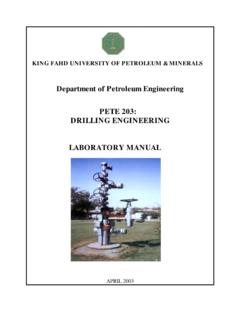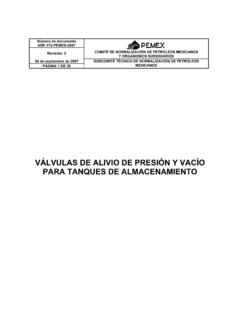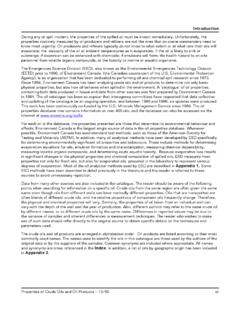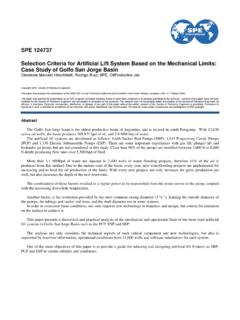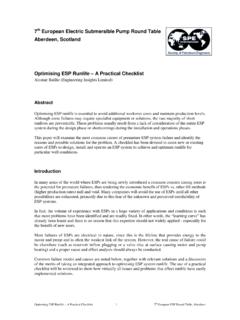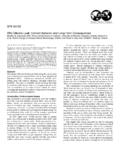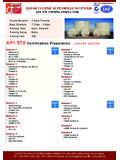Transcription of Artificial-Lift Systems Overview and Evolution in a …
1 Copyright 2007, society of petroleum Engineers This paper was prepared for presentation at the 2007 SPE Latin American and Caribbean petroleum Engineering Conference held in Buenos Aires, Argentina, 15 18 April 2007. This paper was selected for presentation by an SPE Program Committee following review of information contained in an abstract submitted by the author(s). Contents of the paper, as presented, have not been reviewed by the society of petroleum Engineers and are subject to correction by the author(s). The material, as presented, does not necessarily reflect any position of the society of petroleum Engineers, its officers, or members. Papers presented at SPE meetings are subject to publication review by Editorial Committees of the society of petroleum Engineers.
2 Electronic reproduction, distribution, or storage of any part of this paper for commercial purposes without the written consent of the society of petroleum Engineers is prohibited. Permission to reproduce in print is restricted to an abstract of not more than 300 words; illustrations may not be copied. The abstract must contain conspicuous acknowledgment of where and by whom the paper was presented. Write Librarian, SPE, Box 833836, Richardson, Texas 75083-3836 , fax 01-972-952-9435. Abstract The Golfo San Jorge basin, located in the central Patagonia, is the oldest productive basin of Argentina, where the first economic discovery took place in 1907, in Comodoro Rivadavia.
3 With 11,680 active oil wells, is the first oil producer basin of Argentina producing 258,549 bpd of oil and MM bpd of water. The main characteristics of the basin are: - Faults and sand stone lens - HWOR - Increasing fluid flow rate per well - Complex fluids: corrosive, heavy oil, gas, sand and scale - Multiphase fluids - Multilayer reservoir: from to 9000 feet In this context, the selection, operation and optimization of the different artificial Lift Systems (ALS) plays an important role for following the development of the basin. This paper describes the best practices, experiences and trends, using ALS as Progressing Cavity Pump(PCP), Electric Submersible Pump(ESP) and Sucker Rod Pumping(SRP); and a basic description about Gas Lift, Plunger Lift and Hydraulic jet Pumping experiences.
4 Information as pump depth, flow rates, operational conditions, surface and sub-surface installations description, technical limits, failures statistic and new technologies from more than 9,000 active wells from different oilfields were collected and analyzed. As result of this Overview , an ALS reference guide was completed with parameters and benchmarking indicators; and some important conclusions appear. Complementary information will be presented in the Appendix (Fig-A1, A2, Table-A1, etc) Introduction The East-West trending Golfo San Jorge basin is the oldest and most prolific oil basin of Argentina It covers 28,000 M Acre, with 1,127 MMbo (Dec-05) of OOIP and is located in the central Patagonia.
5 (Fig-A1) The first commercial oil discovery took place in 1907 and since then close to 2,900 MMBOE were extracted. Located in the central part of Patagonia Terrane, it is an intracratonic extensional basin. During late Jurassic-early Cretaceous times, the extension related to the Gondwana break-up generated many isolated small half-graben basins, with a NW-SE structural trend. Later, a new extensional-transtensional stress field originated a WNW-ESE trending, and reduced extensional deformation continued until the Oligocene. The basin is essentially asymmetric; in the eastern section the dominant extensional faults are on the northern flank with the southern flanks being a less faulted, flexural type margin.
6 In contrast, the western section is asymmetric but its major faults are on the southern flank, being the northern flank a flexural margin. The central section of the San Jorge basin is dominated by NW and NNW trending extensional faults that were reactivated by compression in Tertiary times. The basin produces 258,549 bpd of oil (44 % of the oil production of Argentina), and MM bdp of water (91%) at November 2006. Close to MMbpd of water are injected in 2,400 wells in water flooding projects, therefore 41% of the oil is produced from this method. (Fig-A2) Close to 97 % of the wells were completed with 5 casing, and depending on the companies, new wells are completed with 7 casing.
7 Vertical wells are the most common and directional wells are drilled in some projects (water flooding, parallel to faults) artificial Lift system (ALS) in Golfo San Jorge From the begining of the activity in Golfo San Jorge Basin, 100 years ago, several ALS have been used in order to produce the oil from each well. The basin offers different conditions depending the mature state of the oilfields: high water percentage, high and low flow rate, free gas and in solution, heay and light oil, flowing wells and high GOR reservoirs . SPE 108054 Artificial-Lift Systems Overview and Evolution in a Mature Basin: Case Study of Golfo San Jorge Marcelo Hirschfeldt, Paulino Martinez, Fernando Distel. Universidad Nacional de la Patagonia San Juan Bosco.
8 Argentina 2 SPE 108054 At the present time, ALS as SRP, PCP and ESP are the most popular Systems used for producing 98 % of the total fluid of the basin. And in smaller quantity, wells produced by hydraulic jet pump, pluger and gas lift. The growing reservoir depth and flow rate of fluid per well, present a permanent challenger for the different ALS and specialist. In this context, the selection, operation and optimization of the different Systems plays one of the most important roles for following the basin development.
9 One of the common factors in all oil wells, is the casing diameter, where 5 diameter forces to use 2 tubing and 1 sucker rod. For this reason during the last years, one of the main targets of the companies and engineers has been to increase the technical limit and life of each system . Distribution and Evolution The number of active oil wells is 11,887 with the follow distribution: Others: Hydraulic Jet pump, Plunger and Gas Lift ( ) The shows the Evolution of the most important artificial lift Systems from 1999. During the last eight years, the number of wells per system it has grown in function of the advance of the technology and of the new requirements of the basin.
10 PCP is the system that increased the number 237 % from 1999. One of the reasons for this important growth is the new development in materials as elastomers, sucker rods, pumps design and surface instalations. And in the other hand, the field engineers and companies began to study the system and to try new challenges. The second is the ESP with 224 %, where the growing reservoirs depth and flow rate in water flooding projects forced to the system to reach demanding production forecast One of the performance indicators we use to measure the failure index of the system is the Pulling Jobs per Well per Year. Failure index (FI)=(Pull. Jobs per month /num.)
